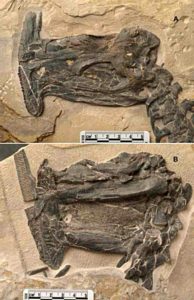Nearly two years ago, an international team of paleontologists discovered a bizarre fossil — Atopodentatus unicus, a 10 feet (3 m) long marine reptile that lived in what is now China 247 to 242 million years ago (Middle Triassic).
Atopodentatus unicus’ head was poorly preserved, but it seemed to have a flamingo-like ‘beak.’
But according to a new paper, published in the journal Science Advances, that beak is actually part of a hammerhead-shaped jaw apparatus, whichAtopodentatus unicus used to feed on plants on the ocean floor.
It’s the earliest known example of a plant-eating marine reptile.

Life restoration of Atopodentatus unicus. Image credit: Institute of Vertebrate Paleontology and Paleoanthropology.
“The wide jaw of Atopodentatus unicus was shaped like a hammerhead, and along the edge, it had peg-like teeth. Then, further into its mouth, it had bunches of needle-like teeth,” said co-author Dr. Olivier Rieppel from Field Museum in Chicago.
“That arrangement wouldn’t have been too useful for chewing prey.”
To figure out how Atopodentatus unicus’ jaw fit together and how the reptile actually fed, the scientists bought some children’s clay and rebuilt it with toothpicks to represent the teeth.

Prepared skulls of the newly-discovered specimens of Atopodentatus unicus. Scale bar – 2 cm. Image credit: Institute of Vertebrate Paleontology and Paleoanthropology.
“We looked at how the upper and lower jaw locked together, and that’s how we proceeded and described it,” Dr. Rieppel said.
The verdict: Atopodentatus unicus used its bizarre jaw to help it eat plants.
“Atopodentatus unicus used its front teeth to nip algae or other plants from rocky surfaces and then, with its mouth closed, forced mouthfuls of water through its side teeth, which acted as a filter trapping the plants and letting the water back out, like how whales filter-feed with their baleen,” Dr. Rieppel explained.
Not only does this discovery solve the mystery of the strange-toothedAtopodentatus unicus, but it also provides us with an example of the first herbivorous marine reptile.
“The jaw structure is clearly that of an herbivore. It has similarities to other marine animals that ate plants with a filter-feeding system, but Atopodentatus unicus is older than them by about 8 million years,” Dr. Rieppel said.
This reptile also helps tell a bigger story about the world’s largest mass extinction 252 million years ago.
“Animals living the years surrounding the Permian-Triassic extinction help us see how life on Earth reacted to that event,” Dr. Rieppel said.
“The existence of specialized animals like Atopodentatus unicus shows us that life recovered and diversified more quickly than previously thought. And it’s definitely a reptile that no one would have thought to exist.”
Courtesy: Li Chun et al. 2016. The earliest herbivorous marine reptile and its remarkable jaw apparatus. Science Advances, vol. 2, no. 5, e1501659; doi: 10.1126/sciadv.1501659
Key: WFS,World Fossil Society,Riffin T Sajeev,Russel T Sajeev



 June 27th, 2016
June 27th, 2016  Riffin
Riffin  Posted in
Posted in  Tags:
Tags: 